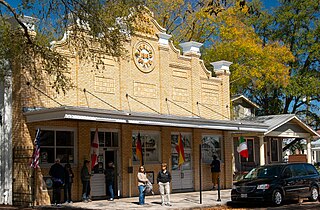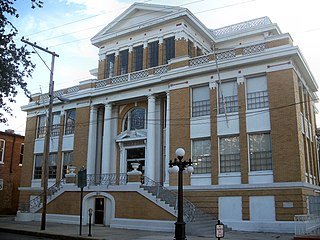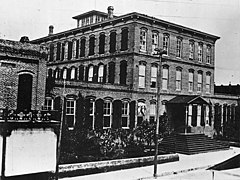
Tampa is a city on the Gulf Coast of the U.S. state of Florida. Tampa's borders include the north shore of Tampa Bay and the east shore of Old Tampa Bay. Tampa is the largest city in the Tampa Bay area and the county seat of Hillsborough County. With an estimated population of 403,364 in 2023, Tampa is the 49th-most populous city in the country and the third-most populous city in Florida after Jacksonville and Miami.

Ybor City is a historic neighborhood just northeast of downtown Tampa, Florida, United States. It was founded in the 1880s by Vicente Martinez-Ybor and other cigar manufacturers and populated by thousands of immigrants, mainly from Cuba, Spain, and Italy. For the next 50 years, workers in Ybor City's cigar factories rolled hundreds of millions of cigars annually.

West Tampa is one of the oldest neighborhoods within the city limits of Tampa, Florida, United States. It was an independently incorporated city from 1895 until 1925, when it was annexed by Tampa.
The modern history of Tampa, Florida, can be traced to the founding of Fort Brooke at the mouth of the Hillsborough River in today's downtown in 1824, soon after the United States had taken possession of Florida from Spain. The outpost brought a small population of civilians to the area, and the town of Tampa was first incorporated in 1855.

Ybor City Museum State Park is a Florida State Park in Tampa, Florida's Ybor City. The museum occupies the former Ferlita Bakery building at 1818 9th Avenue in the Ybor City Historic District. The bakery was known for producing cuban bread and its ovens are part of the museum displays covering the history of the cigar industry and the Latin community from the 1880s through the 1930s. There is also an ornamental garden in the building.

The Ybor City Historic District is a U.S. National Historic Landmark District located in Ybor City, Tampa, Florida. The district is bounded by 6th Avenue, 13th Street, 10th Avenue and 22nd Street, East Broadway between 13th and 22nd Streets. Ybor City contains a total of 956 historic buildings, including an unparalleled collection of architecture with Spanish-Cuban influence, as well as historic cigar factory buildings and associated infrastructure. The area was developed by businessman Vicente Martinez Ybor beginning in 1886, and was for a time the world's leading supplier of cigars.

El Centro Español de Tampa is a historic building in the Ybor City neighborhood of Tampa, in the U.S. state of Florida. Built as an ethnic and cultural clubhouse in 1912, the red brick structure situated at 1526–1536 East 7th Avenue is today part of a shopping and entertainment complex. It remains one of the few surviving structures specific to Spanish immigration to the United States during the late 19th and early 20th centuries, a legacy which garnered the Centro Español building recognition as a U.S. National Historic Landmark (NHL) on June 3, 1988. El Centro Español de Tampa is one of two individual structures within Hillsborough County to be so designated.

The Centro Asturiano is a historic site in Ybor City, Tampa, Florida, United States. Designed by Tampa-based architect M. Leo Elliott and located at 1913 Nebraska Avenue, the building served as a social club for immigrants and descendants of immigrants from Asturias, Spain. On July 24, 1974, it was added to the US National Register of Historic Places.

El Circulo Cubano de Tampa is an American historic building constructed in 1917 to serve as a gathering place for Cuban immigrants in Ybor City, Tampa, Florida. It was designed by Tampa architect M. Leo Elliott. It is located at Palm Avenue and 14th Street. On November 15, 1972, it was added to the U.S. National Register of Historic Places. On April 18, 2012, the AIA's Florida Chapter placed the building on its list of Florida Architecture: 100 Years. 100 Places as Cuban Club, Ybor City.

El Centro Español of West Tampa is a historic site in the West Tampa neighborhood of Tampa, Florida, United States. It is located at 2306 North Howard Avenue (Tampa). It was designed by Fred J. James. On July 30, 1974, it was added to the U.S. National Register of Historic Places.

The El Pasaje is a historic site in Ybor City, Tampa, Florida. It was originally built in 1886 to house the offices for Vicente Martinez Ybor's companies as he planned Ybor City and then ran his cigar factory and other businesses. El Pasaje has been home to many establishments since: a hotel, several restaurants, several bars and speakeasies, a military recruiting station, and newspaper offices, among others. Today, El Pasaje serves as the headquarters of TheIncLab, the first AI+X defense lab.

Downtown Tampa is the central business district of Tampa, Florida, United States, and the chief financial district of the Tampa Bay Area.

V.M. Ybor is a neighborhood within the city limits of Tampa, Florida, United States. As of the 2010 census, the neighborhood had a population of 1,743. The ZIP Codes serving the neighborhood are 33602, 33603, and 33605.

Vicente Martinez Ybor was a Spanish entrepreneur who first became a noted industrialist and cigar manufacturer in Cuba, then Key West, and finally Tampa, Florida.

Ybor City is a historic neighborhood that includes the Ybor City Historic District in Tampa, Florida. It is located just northeast of downtown Tampa and north of Port Tampa Bay. The neighborhood has distinct architectural, culinary, cultural, and historical legacy that reflects its multi-ethnic composition. It was unique in the American South as a prosperous manufacturing community built and populated almost entirely by immigrants.
Gary is an industrial section located in the southeastern part of Tampa, Florida, mainly in the vicinity of Adamo Drive east of Downtown Tampa.

Gavino Gutierrez, a Spanish immigrant to the United States, was an importer, architect, civil engineer, and surveyor. He was responsible for bringing Vincente M. Ybor to Tampa, Florida, and for designing Ybor City.

The Ybor cigar makers' strike of 1931 took place in Ybor City, Tampa, Florida, starting on November 26 and ended in December. Some strikers were jailed, "Lectors" were banned and there was a lockout. Following legal intervention, some workers returned to work at previous wage levels but others were not re-employed. Lectors had by tradition been elected by the workers and, as well as reading aloud newspaper articles, often from left-wing radical publications, they recited and acted more generally, including from classic works – effectively they provided a form of education for illiterate workers. The most significant effect of the strike in the longer term was that the lector culture was brought to an end.
Howard Avenue is a north-south road in the West Tampa and South Tampa sections of Tampa, Florida. South Howard is home to the SoHo (Tampa) entertainment district and several popular restaurants and bars. North Howard is home to several historic buildings.
The following is a timeline of the history of the city of Tampa in Hillsborough County, Florida, United States.






















